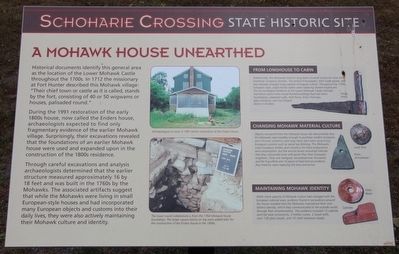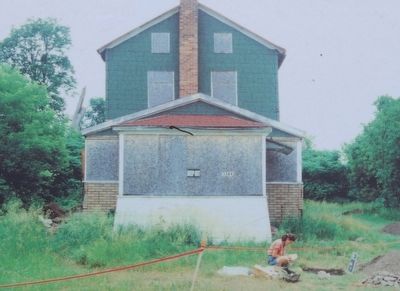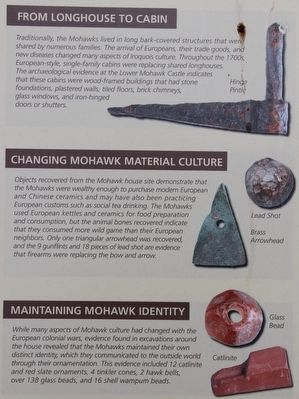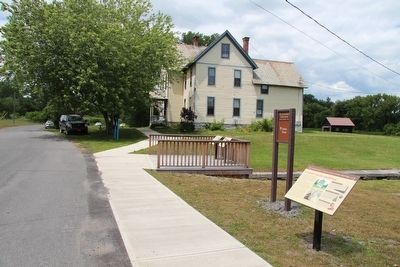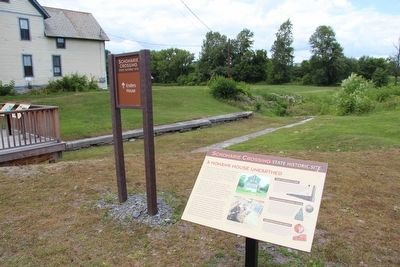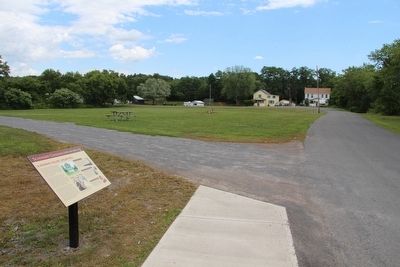Fort Hunter in Montgomery County, New York — The American Northeast (Mid-Atlantic)
A Mohawk House Unearthed
Schoharie Crossing
— State Historic Site —
Historical documents identify this general area as the location of the Lower Mohawk Castle throughout the 1700s. In 1712 the missionary at Fort hunter described this Mohawk village: "Their chief town or castle as it is called, stands by the fort, consisting of 40 or 50 wigwams or houses, palisaded round."
During the 1991 restoration of the early 1800s house, now called the Enders house, archaeologists expected to find only fragmentary evidence of the earlier Mohawk village. Surprisingly, their excavations revealed that the foundations of an earlier Mohawk house were used and expanded upon in the construction of the 1800s residence.
Through careful excavations and analysis archaeologists determined that the earlier structure measured approximately 16 by 18 feet and was built in the 1760s by the Mohawks. The associated artifacts suggest that while the Mohawks were living in small European-style houses and had incorporated many European objects and customs into their daily lives, they were also actively maintaining their Mohawk culture and identity.
From Longhouse to Cabin:
Traditionally, the Mohawks lived in long bark-covered structures that were shared by numerous families. The arrival of Europeans, their trade goods, and new diseases changed many aspects of Iroquois culture. Throughout the 1700s, European-style, single-family cabins were replacing shared longhouses. The archaeological evidence at the Lower Mohawk Castle indicates that these cabins were wood-framed buildings that had stone foundations, plastered walls, tiled floors, brick chimneys, glass windows, and iron-hinged doors or shutters.
Changing Mohawk Material Culture:
Objects recovered from the Mohawk house site demonstrate that the Mohawks were wealthy enough to purchase modern European and Chinese ceramics and may have also been practicing European customs such as social tea drinking. The Mohawks used European kettles and ceramics for food preparation and consumption, but the animal bones recovered indicate that they consumed more wild game than their European neighbors. Only one triangular arrowhead was recovered, and the 9 gunflints and 18 pieces of lead shot are evidence that firearms were replacing the bow and arrow.
Maintaining Mohawk Identity:
While many aspects of Mohawk culture had changed with the European colonial wars, evidence found in excavations around the house revealed that the Mohawks maintained their own distinct identity, which they communicated to the outside world through their ornamentation. This evidence included 12 catlinite and red slate ornaments, 4 tinkler cones, 2 hawk bells,
over 138 glass beads, and 16 shell wampum beads.
Topics. This historical marker is listed in these topic lists: Colonial Era • Native Americans.
Location. 42° 56.357′ N, 74° 16.904′ W. Marker is in Fort Hunter, New York, in Montgomery County. Marker is on Schoharie Street south of Main Street, on the left when traveling south. This marker is on the site of the grounds of the Schoharie Crossing, State Historic Site, a short distance south of the State Historic Site Visitor Center, and next to the East Guard Lock. Touch for map. Marker is in this post office area: Fort Hunter NY 12069, United States of America. Touch for directions.
Other nearby markers. At least 8 other markers are within walking distance of this marker. Site of Old Fort Hunter (here, next to this marker); Site of Last Mohawk Indian Village (a few steps from this marker); East Guard Lock (a few steps from this marker); Original Erie Canal (a few steps from this marker); Site of First Bridge (a few steps from this marker); Site of Queen Anne Chapel (a few steps from this marker); Building Block of the Erie Canal (within shouting distance of this marker); The Fort by the Village (within shouting distance of this marker). Touch for a list and map of all markers in Fort Hunter.
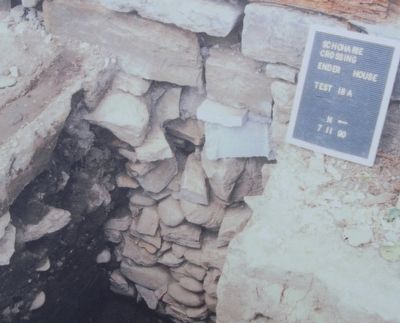
Photographed By Dale K. Benington, July 23, 2015
3. A Mohawk House Unearthed Marker
Close-up view, that is displayed on the marker, of a photograph showing the lower round cobblestones that were from the 1760 Mohawk house foundation, and the larger square blocks, on top, that were added later for the construction of the Enders house in the 1800s.
Credits. This page was last revised on June 16, 2016. It was originally submitted on September 8, 2015, by Dale K. Benington of Toledo, Ohio. This page has been viewed 566 times since then and 35 times this year. Photos: 1, 2, 3, 4, 5, 6, 7. submitted on September 10, 2015, by Dale K. Benington of Toledo, Ohio.
